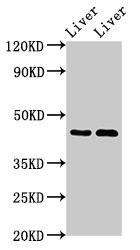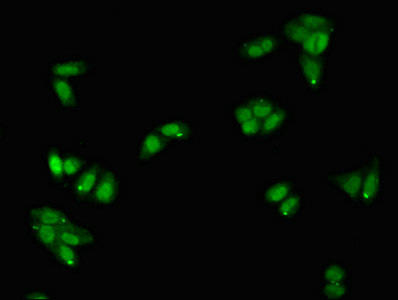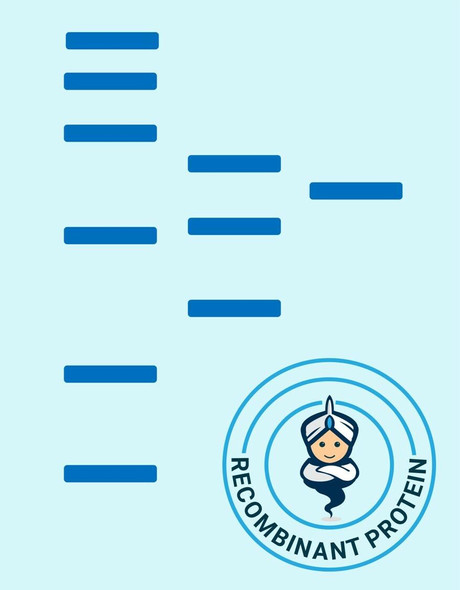SERPINA5 Antibody (PACO54046)
- SKU:
- PACO54046
- Product type:
- Antibody
- Reactivity:
- Human
- Mouse
- Rat
- Host Species:
- Rabbit
- Isotype:
- IgG
- Application:
- ELISA
- Application:
- WB
- Application:
- IHC
- Application:
- IF
- Antibody type:
- Polyclonal
- Conjugation:
- Unconjugated
Frequently bought together:
Description
| Antibody Name: | SERPINA5 Antibody (PACO54046) |
| Antibody SKU: | PACO54046 |
| Size: | 50ug |
| Host Species: | Rabbit |
| Tested Applications: | ELISA, WB, IHC, IF |
| Recommended Dilutions: | ELISA:1:2000-1:10000, WB:1:500-1:5000, IHC:1:20-1:200, IF:1:50-1:200 |
| Species Reactivity: | Human, Mouse, Rat |
| Immunogen: | Recombinant Human Plasma serine protease inhibitor protein (157-367AA) |
| Form: | Liquid |
| Storage Buffer: | Preservative: 0.03% Proclin 300 Constituents: 50% Glycerol, 0.01M PBS, pH 7.4 |
| Purification Method: | >95%, Protein G purified |
| Clonality: | Polyclonal |
| Isotype: | IgG |
| Conjugate: | Non-conjugated |
 | Western Blot. Positive WB detected in: Rat liver tissue, Mouse liver tissue. All lanes: SERPINA5 antibody at 3µg/ml. Secondary. Goat polyclonal to rabbit IgG at 1/50000 dilution. Predicted band size: 46 kDa. Observed band size: 46 kDa. |
 | Immunofluorescent analysis of HepG2 cells using PACO54046 at dilution of 1:100 and Alexa Fluor 488-congugated AffiniPure Goat Anti-Rabbit IgG(H+L). |
 | Immunohistochemistry analysis of human ovarian cancer using PACO54046 at dilution of 1:100. |
| Background: | Heparin-dependent serine protease inhibitor acting in body fluids and secretions. Inactivates serine proteases by binding irreversibly to their serine activation site. Involved in the regulation of intravascular and extravascular proteolytic activities. Plays hemostatic roles in the blood plasma. Acts as a procoagulant and proinflammatory factor by inhibiting the anticoagulant activated protein C factor as well as the generation of activated protein C factor by the thrombin/thrombomodulin complex. Acts as an anticoagulant factor by inhibiting blood coagulation factors like prothrombin, factor XI, factor Xa, plasma kallikrein and fibrinolytic enzymes such as tissue- and urinary-type plasminogen activators. In seminal plasma, inactivates several serine proteases implicated in the reproductive system. Inhibits the serpin acrosin; indirectly protects component of the male genital tract from being degraded by excessive released acrosin. Inhibits tissue-and urinary-type plasminogen activator, prostate-specific antigen and kallikrein activities; has a control on the sperm motility and fertilization. Inhibits the activated protein C-catalyzed degradation of SEMG1 and SEMG2; regulates the degradation of semenogelin during the process of transfer of spermatozoa from the male reproductive tract into the female tract. In urine, inhibits urinary-type plasminogen activator and kallikrein activities. Inactivates membrane-anchored serine proteases activities such as MPRSS7 and TMPRSS11E. Inhibits urinary-type plasminogen activator-dependent tumor cell invasion and metastasis. May also play a non-inhibitory role in seminal plasma and urine as a hydrophobic hormone carrier by its binding to retinoic acid, |
| Synonyms: | Plasma serine protease inhibitor (Acrosomal serine protease inhibitor) (Plasminogen activator inhibitor 3) (PAI-3) (PAI3) (Protein C inhibitor) (PCI) (Serpin A5), SERPINA5, PCI PLANH3 PROCI |
| UniProt Protein Function: | SERPINA5: Heparin-dependent serine protease inhibitor acting in body fluids and secretions. Inactivates serine proteases by binding irreversibly to their serine activation site. Involved in the regulation of intravascular and extravascular proteolytic activities. Plays hemostatic roles in the blood plasma. Acts as a procoagulant and proinflammatory factor by inhibiting the anticoagulant activated protein C factor as well as the generation of activated protein C factor by the thrombin/thrombomodulin complex. Acts as an anticoagulant factor by inhibiting blood coagulation factors like prothrombin, factor XI, factor Xa, plasma kallikrein and fibrinolytic enzymes such as tissue- and urinary- type plasminogen activators. In seminal plasma, inactivates several serine proteases implicated in the reproductive system. Inhibits the serpin acrosin; indirectly protects component of the male genital tract from being degraded by excessive released acrosin. Inhibits tissue-and urinary-type plasminogen activator, prostate-specific antigen and kallikrein activities; has a control on the sperm motility and fertilization. Inhibits the activated protein C-catalyzed degradation of SEMG1 and SEMG2; regulates the degradation of semenogelin during the process of transfer of spermatozoa from the male reproductive tract into the female tract. In urine, inhibits urinary-type plasminogen activator and kallikrein activities. Inactivates membrane-anchored serine proteases activities such as MPRSS7 and TMPRSS11E. Inhibits urinary-type plasminogen activator-dependent tumor cell invasion and metastasis. May also play a non-inhibitory role in seminal plasma and urine as an hydrophobic hormone carrier by its binding to retinoic acid. Belongs to the serpin family. |
| UniProt Protein Details: | Protein type:Secreted, signal peptide; Secreted Chromosomal Location of Human Ortholog: 14q32.1 Cellular Component: acrosomal membrane; external side of plasma membrane; extracellular region; extracellular space; membrane; protein complex Molecular Function:acrosin binding; glycosaminoglycan binding; heparin binding; phosphatidylcholine binding; protease binding; protein binding; retinoic acid binding; serine-type endopeptidase inhibitor activity Biological Process: blood coagulation; negative regulation of hydrolase activity; spermatogenesis |
| NCBI Summary: | The protein encoded by this gene is a member of the serpin family of proteins, a group of proteins that inhibit serine proteases. This gene is one in a cluster of serpin genes located on the q arm of chromosome 14. This family member is a glycoprotein that can inhibit several serine proteases, including protein C and various plasminogen activators and kallikreins, and it thus plays diverse roles in hemostasis and thrombosis in multiple organs. [provided by RefSeq, Aug 2012] |
| UniProt Code: | P05154 |
| NCBI GenInfo Identifier: | 322510122 |
| NCBI Gene ID: | 5104 |
| NCBI Accession: | P05154.3 |
| UniProt Secondary Accession: | P05154,Q07616, Q9UG30, |
| UniProt Related Accession: | P05154 |
| Molecular Weight: | 45,675 Da |
| NCBI Full Name: | Plasma serine protease inhibitor |
| NCBI Synonym Full Names: | serpin family A member 5 |
| NCBI Official Symbol: | SERPINA5 |
| NCBI Official Synonym Symbols: | PCI; PAI3; PAI-3; PCI-B; PROCI; PLANH3 |
| NCBI Protein Information: | plasma serine protease inhibitor |
| UniProt Protein Name: | Plasma serine protease inhibitor |
| UniProt Synonym Protein Names: | Acrosomal serine protease inhibitor; Plasminogen activator inhibitor 3; PAI-3; PAI3; Protein C inhibitor; PCI; Serpin A5 |
| Protein Family: | Plasma serine protease inhibitor |
| UniProt Gene Name: | SERPINA5 |
| UniProt Entry Name: | IPSP_HUMAN |
| Secondary Antibody |
| Anti-HRP Goat Anti-Rabbit IgG (H+L) Antibody (CABS014) |
| Recommended Products |
| Anti-FITC Goat Anti-Rabbit IgG (H+L) Antibody (CABS011) |
| Anti-HRP-conjugated Beta Actin Antibody (CABC028) |









